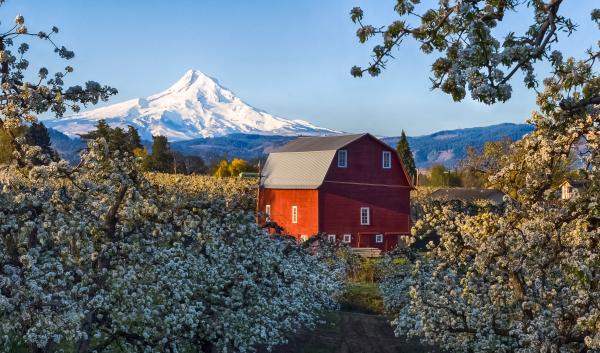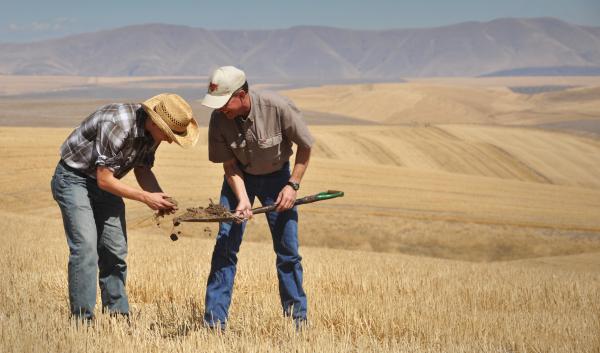Estimated reading time: 4 minutes

Agrivoltaics (also known as dual-use solar and agrisolar) pairs solar power generation with agriculture, generating energy and providing space for crops, grazing, and pollinator and native habitats beneath and between solar panels. Solar panels can offer plants and animals partial shade and protection from extreme heat and drought, while evapotranspiration from plants can cool solar panels and improve their energy generation.
Agrivoltaics can also reduce conflicts over land requirements for agriculture and renewable energy production. Because traditional solar sites often require the same type of land that is suitable for agriculture, there are concerns that traditional solar sites could limit agricultural production in the region. However, agrivoltaics reduces these concerns by co-locating agriculture and solar and providing potential benefits to producers. Though agrivoltaic systems require thoughtful design, in the right conditions they present an opportunity to balance agricultural and renewable energy production goals.
There are three main types of agrivoltaic systems: elevated, inter-row, and a combination of the two. Elevated systems place solar panels directly above vegetation, usually elevated by at least 6 feet. Elevated systems can protect vegetation from extreme weather such as heavy rains and drought and can reduce sun exposure. Crops such as berries, grapes, and apples can be found in elevated systems. In inter-row systems, vegetation is grown between rows of solar panels rather than beneath them. Typically, inter-row systems do not provide the same level of protection against extreme weather but crops usually have more access to direct sunlight than in elevated systems. Rows of panels can be spaced out widely enough to allow tractors and other equipment to cultivate vegetation in between. Crops such as grasses, grains, and hardy vegetables (e.g., kale and broccoli) can be found in inter-row systems. Beekeeping and livestock grazing can occur in both elevated and inter-row systems, as can habitat restoration.
How can agrivoltaics help the Northwest mitigate and adapt to climate change?
Climate change has caused unprecedented warming, varying precipitation patterns, and higher risks of drought and wildfires across the Northwest. These impacts threaten agriculture, natural resources, and human health in the region. Transitioning from fossil fuels to renewable forms of energy can reduce carbon emissions and slow the effects of climate change.
Recently, the Biden-Harris administration set a goal to decarbonize the U.S. electricity sector by 2035. Northwest states are working to meet this goal through emission reduction mandates and renewable energy projects. For example, Washington (which is second in the nation for renewable energy generation) is working to reduce 95% of the state’s greenhouse gas emissions by 2050. Oregon is requiring that 50% of the electricity sold in Oregon comes from renewable sources by 2040. Renewable energy already accounts for 70% of Oregon’s and 75% of Idaho’s total in-state electricity. Alaska has a non-binding state-wide goal to generate 50% of its electricity from renewable and alternative energy sources by 2025. States want to meet renewable energy goals, but concerns over land use continue.
Agrivoltaics could provide an energy and agricultural solution. A recent Oregon State University study found that converting less than 1% of U.S. agricultural land to agrivoltaics could meet 20% of the country’s energy need. Although traditional solar project sites can compete with agricultural land for space and contribute to land-use conversion, agrivoltaics could help the Northwest transition to renewable energy while minimizing impacts to agriculture and agricultural land.
Potential benefits
In addition to mitigating carbon emissions and reducing solar siting conflicts, agrivoltaic systems have the potential to:
- Reduce energy costs for producers. The electricity generated by solar panels can be used to power farm operations, which can reduce energy costs. Plants also help to cool solar panels, improving power generation.
- Increase farm income. Producers can continue to grow crops while harnessing solar power to meet their own energy needs. In some cases, panels may generate enough energy to sell the excess back to the grid, increasing and stabilizing farm income.
- Improve crop resilience: The shade provided by solar panels can help protect some crops from the impacts of extreme heat and drought.
- Improve water-use efficiency: The shade provided by agrivoltaic systems can reduce water demands for some crops and vegetation. Agrivoltaic systems have the potential to improve productivity in dryland farming by reducing water demands.
- Create grazing land opportunities: Sheep and chickens can graze around and beneath solar panels, ensuring that plants do not shade panels. In return, panels offer shade for grazing animals.
- Improve pollinator habitat. Solar sites can provide forage for native pollinators and honeybees. Partial shading by solar panels can also delay blooms and increase floral abundance during the late summer season, when traditional pollinator forage is less available. Agrivoltaic sites can also be used for beekeeping.
- Reduce farm workers’ exposure to extreme heat. In agrivoltaic systems, farm workers can work and rest in the shade of solar panels.
Challenges
A number of existing challenges need to be addressed to make agrivoltaics a more widespread and adoptable practice. These include:
- Restrictions on land use: Several states (including Oregon) have placed restrictions on commercial solar development to protect farmlands with high-value soil from development. However, restrictions in Oregon still allow for 20-acre agrivoltaic developments on farmland.
- Cost: Agrivoltaic solar panels are more costly than traditional solar panels, as they can require additional settings, space, and other specializations. However, the energy generated by solar panels can help to offset these costs over time.
- Meticulous design: The design of agrivoltaic systems needs to be carefully considered in order to maximize benefits and minimize drawbacks. For example, agrivoltaics may not work in areas that do not receive a lot of sunlight, or with crops that require a lot of direct sunlight.
- Cultivation considerations: Crops do not always respond predictably to agrivoltaic settings. Producers may have to experiment with crops and reseeding to achieve desired results.
- Impacts to soil quality: Installation of solar panels can cause soil compaction and reduce soil quality. However, innovations in installation methods and soil decompaction after installation can improve conditions.
Agrivoltaics in the Northwest

Throughout the Northwest, agrivoltaic systems are being researched for their potential to mitigate greenhouse gas emissions, supply renewable energy, and increase the climate resilience of farms. In Alaska, researchers with the University of Alaska-Fairbanks are testing whether crops commonly grown in the state can succeed in agrivoltaic settings. Meanwhile, researchers at Oregon State University have determined that sheep reared in agrivoltaic settings prefer to graze in the shade of solar panels. The study also found that, despite finding less forage in solar pastures, lamb production did not differ from lambs grazed in open fields. A 2021 project in Oregon found that potatoes grown in the shade of solar panels had an overall yield increase of 20% compared to potatoes grown in full sun. Researchers in Oregon are also exploring how agrivoltaics can be used to reduce drought stress and blossom end rot in dry-farmed tomatoes. Pollinator-friendly solar sites are also being created.
Though more research is needed to determine the efficacy and feasibility of agrivoltaic systems throughout the Northwest, existing evidence suggests agrivoltaics could be a useful tool to increase food and energy security in the Northwest.
Dual Use Solar in the Pacific Northwest is a guide from Renewable Northwest that explores the concept of agrivoltaics throughout the United States and its application in Oregon and Washington.
The 5 Cs of Agrivoltaic Success Factors in the United States: Lessons from the InSPIRE Research Study outlines the five elements that determine the feasibility of agrivoltaic systems in given situations.
- The INSPIRE Agrivoltaics Financial Calculator includes an agrivoltaics primer, published research portal, and map of sites in the United States.
Solar Leasing: A Guide for Agricultural Landowners in the Pacific Northwest is a USDA National Institute of Food and Agriculture-funded guide that walks landowners through the process of gathering information, making a decision, and negotiating a solar lease.
AgriSolar Clearinghouse connects businesses, land managers, and researchers with trusted resources to support the growth of co-located solar and sustainable agriculture.
- Financial information: funding, incentives, tax breaks, and programs
Farmer’s Guide to Going Solar is a Department of Energy webpage that answers frequently asked questions about converting farmland to agrivoltaics.
Oregon State University Nexus of Energy, Water, and Agriculture Lab is led by researcher Chad Higgins and explores the physical, operational, and geospatial connections in the energy-water-food nexus, including agrivoltaics.
Powering Affordable Clean Energy (PACE) Funding is a USDA Rural Development loan forgiveness program that forgives up to 60 percent of loans for renewable energy projects that use wind, solar, hydropower, geothermal, or biomass, as well as for renewable energy storage projects.
-
Agriculture in the Northwest
A summary of agriculture in Idaho, Oregon, and Washington and the effects of climate change on Northwest agriculture.
-
Northwest No-Till Farming for Climate Resilience
No-till farming keeps crop residues on farmland, protects soil, and limits the release of greenhouse gases.
-
Climate Change Impacts in the Northwest
A summary of current and expected impacts due to climate change in the Northwest.




